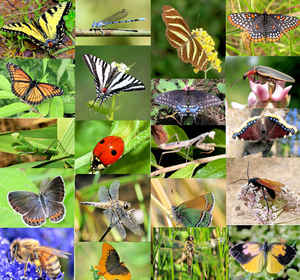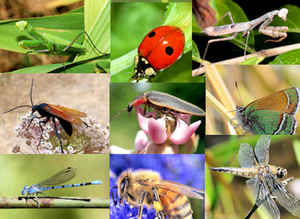
Vermont Symbols
Vermont State Insect
Honeybee

(Apis mellifera)
Adopted on July 1, 1978.
No. 124 of the Acts of 1978, effective July 1, 1978, designated the Honeybee, (Apis mellifera,) as the official State Insect. This "social" insect, which grows and lives in highly organized colonies, is important to Vermont farmers and orchardists by being a principal pollinator of certain of their crops. But it is best know, of course, for the pleasant-tasting and healthful honey which it produces. Though they represent a relatively small part of the state's agricultural economy, Vermont beekeepers generally produce several hundred thousand pounds of honey each year.
Did you know that: The honey bee has been proclaimed the official state insect in each of the following states:
Arkansas | Georgia | Kansas
| Kentucky | Louisiana
Maine | Mississippi |
Missouri | Nebraska | New Jersey
North Carolina | Oklahoma | South
Dakota | Tennessee
Utah | Vermont | West Virginia
| Wisconsin
Vermont State Insect: Honeybee

This "social" insect, which grows and lives in highly organized colonies, is important to Vermont farmers and orchardists by being a principal pollinator of certain of their crops. But it is best know, of course, for the pleasant-tasting and healthful honey which it produces. Though they represent a relatively small part of the state's agricultural economy, Vermont beekeepers generally produce several hundred thousand pounds of honey each year.
Bees produce honey as food stores for the hive during the long months of winter when flowers aren't blooming and therefore little or no nectar is available to them. European honey bees, genus Apis Mellifera, produce such an abundance of honey, far more than the hive can eat, that humans can harvest the excess. For this reason, European honey bees can be found in beekeeper's hives around the world!
Honeybees probably originated in Tropical Africa and spread from South Africa to Northern Europe and East into India and China. They were brought to the Americas with the first colonists and are now distributed world-wide. The first bees appear in the fossil record in deposits dating about 40 million years ago in the Eocene. At about 30 million years before present they appear to have developed social behavior and structurally are virtually identical with modern bees.
Characteristics of Vermont Honeybee
Colony:
Honey bees are social insects, with a marked division of labor between the various types of bees in the colony. A colony of honey bees includes a queen, drones and workers.
The Queen:
The queen is the only sexually developed female in the hive. She is the largest bee in the colony.
A two-day-old larva is selected by the workers to be reared as the queen. She will emerge from her cell 11 days later to mate in flight with approximately
18 drone (male) bees. During this mating, she receives several million sperm cells, which last her entire life span of nearly two years.
The queen starts to lay eggs about 10 days after mating. A productive queen can lay 3,000 eggs in a single day.
The Drones:
Drones are stout male bees that have no stingers. Drones do not collect food or pollen from flowers. Their sole purpose is to mate with the queen. If the colony is short on food, drones are often kicked out of the hive.
The Workers:
Workers, the smallest bees in the colony, are sexually undeveloped females. A colony can have 50,000 to 60,000 workers.
The life span of a worker bee varies according to the time of year. Her life expectancy is approximately 28 to 35 days. Workers that are reared in
September and October, however, can live through the winter.
Workers feed the queen and larvae, guard the hive entrance and help to keep the hive cool by fanning their wings. Worker bees also collect nectar to
make honey. In addition, honey bees produce wax comb. The comb is composed of hexagonal cells which have walls that are only 2/1000 inch thick, but
support 25 times their own weight.
Honey bees' wings stroke 11,400 times per minute, thus making their distinctive buzz.
Vermont No. 124 of the Acts of 1978
Legislation signed by Governor Richard A. Snelling named the honeybee the state insect of Vermont.No. 124 of the Acts of 1978, effective
July 1, 1978 [sic], designated the Honeybee as the official State Insect.
This "social" insect, which grows and lives in highly organized colonies, is important to Vermont farmers and orchardists by being a principal
pollinator of certain of their crops. But it is best known, of course, for the pleasant-tasting and healthful honey which it produces.
Though they represent a relatively small part of the state's agricultural economy, Vermont beekeepers generally produce several hundred thousand pounds
of honey each year.
------- from Office of the Secretary of State,
Vermont Legislative Directory and State Manual,
Biennial Session, 1993-1994, p. 17.
Vermont Law
The law designating the honeybee as the official Vermont state insect is found in the Vermont Statutes, Title 1 Chapter 11, Section 502.
TITLE ONE. GENERAL PROVISIONS
CHAPTER 11. FLAG, INSIGNIA, SEAL, ETC.
1 V.S.A. § 502 (2012)
§ 502. State insect
The state insect shall be the honeybee.
HISTORY: Added 1977, No. 124 (Adj. Sess.), § 1, eff. Feb. 17, 1978.
Taxonomic Hierarchy: Western Honey Bee
Kingdom: Animalia (Animals)
Phylum: Arthropoda (Arthropods)
Subphylum: Hexapoda (Hexapods)
Class: Insecta (Insects)
Order: Hymenoptera (Ants, Bees, Wasps and Sawflies)
No Taxon: (Aculeata - Ants, Bees and Stinging Wasps)
No Taxon: (Anthophila (Apoidea) - Bees)
Family: Apidae (Cuckoo, Carpenter, Digger, Bumble, and Honey Bees)
Subfamily: Apinae (Honey, Bumble, Long-horned, Orchid, and Digger Bees)
Tribe: Apini (Honey Bees)
Genus; Apis
Species: mellifera (Western Honey Bee)
Butterflies, and Bugs







